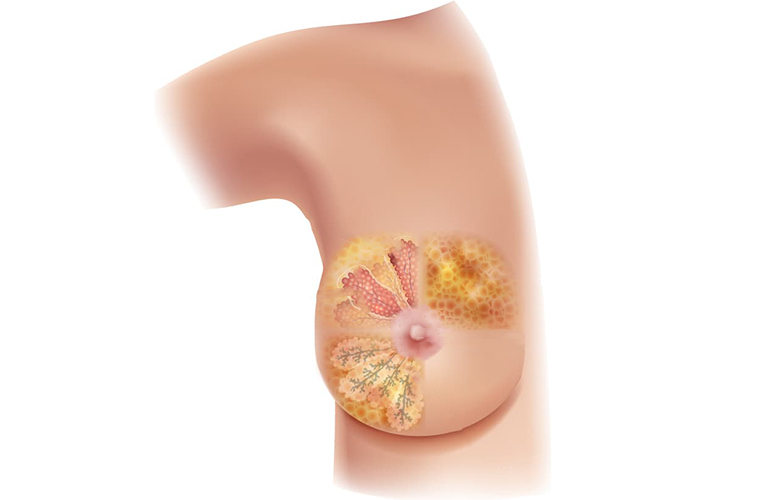
Breast tissue is a modified sweat gland located in the anterior chest wall, whose main function is to meet the nutritional needs of the baby. It shows some differences between men and women. The lobular cell groups that produce milk in men cannot develop, but the ductal structures, which can also be defined as milk ducts, and the intermediate tissue structure are similar to those found in women.
Although breast cancers are the first to come to mind when breast diseases are mentioned, breast tissue can also develop many benign diseases. This is also an indication that every finding in the breast does not mean the presence of cancer.
What Are the Findings in Breast Diseases?
Breast tissue, which is prepared for a pregnancy that may occur in each menstrual cycle, returns to the beginning when pregnancy does not occur. Therefore, it is significantly affected by cyclical hormonal changes. This may lead to recurring complaints or findings in the breast.
Pain in the breast, the presence of a palpable mass, redness, discharge from the nipple in various colors, color changes in the breast skin and structural differences in the skin (redness, swelling, crusting), shape differences that are not present in the other breast, shrinkage and dimples, swelling and lumps in the armpit, swelling and swelling in the arm. Edema may appear as breast findings.
Mastitis (Inflammatory Diseases of the Breast)
Breastfeeding Mastitis (Puerperal Mastitis)
It is the most common infective condition of the breast, which can occur most frequently in the first months after giving birth. The most common cause is bacteria entering through cracks in the nipple that deteriorate during breastfeeding. Patients may have rapidly developing breast pain, redness, swelling and fever.
In this case, the first thing to do is not to interrupt breastfeeding or to empty the breast with the help of pumps, to support the emptying of the breast with warm compresses and massages; following an absolute physician examination, appropriate antibiotics and painkillers are given to the baby and mother.
When deemed necessary, radiological and laboratory investigations may be required. If not treated, the infection may progress rapidly and turn into an abscess with the effect of the milk present in the environment. If an abscess develops, evacuation of the abscess with a needle or, in more advanced cases, by making a surgical incision, is added to other treatments. In some patients, this may be recurrent during breastfeeding.
Although it is very rare, it is very important to consult a doctor, as some infection-like tumors of the breast (inflammatory breast cancer) also create a similar situation.
Breast Abscesses
It usually occurs as a result of breast-feeding mastitis. It can also develop in periductal mastitis or granulomatous mastitis. In their treatment, it is essential that they are emptied first. Despite this, special approaches and additional treatments for disease groups can be applied according to the preference of the physician.
Rarely, patients with diabetes who are sensitive to the immune system, those with chronic kidney failure, or those who have undergone immunosuppressive or tumor-induced chemotherapy for any reason may develop infections and abscesses in various areas of the breast. In these patients, appropriate antibiotics, surgical drainage in the presence of abscess, and biopsy in the presence of doubt may be required.
Chronic Inflammatory Diseases of the Breast (Granulomatous Mastitis)
It is a special mastitis picture that usually creates recurrent infection in the breast. It may occur most frequently due to tuberculosis and similar chronic granulomatous infections, and in some, it may develop due to the immune system without knowing the cause (autoimmune). Recurrent mastitis in the breast can cause abscess formation and discharge from one or more areas with discharge from the skin. At the stage of diagnosis, radiological examinations should also be performed.
Since it is a disease that can be confused with breast cancer, the most definitive diagnosis can be made with biopsy in addition to these imaging methods. In the treatment, observation and mild cases that can be followed are followed. Follow-up periods are kept short during active periods. In addition to classical mastitis and abscess treatment, long-term treatment may be required by planning with appropriate drugs (such as antibiotics, steroids, immune drugs) ranging from immunosuppressants.
Surgical removal of the area can be applied as a patient-specific treatment depending on the stable ongoing cases or the response status after the treatment.
Periductal Mastitis
It is an infective condition that usually occurs in and around the nipple. It is not associated with breastfeeding. It occurs around the milk ducts. Most of the patients are smokers. Its quality can be understood by physician examination and supportive imaging tests. Mild cases can be regressed with appropriate antibiotics.
Abscess
If pus is detected, evacuation of the abscess should be added to the treatment. It is a recurring disease. Surgical removal of diseased canals around the nipple may be required in cases that do not regress with treatments, recur, or whose imaging features raise suspicion of tumor.
Pain in the breast
Breast pain is a problem that most women face at some point in their lives. While pain can be experienced only in a period, in some individuals, it may appear as a constant irritating situation. Cyclic hormonal changes in women of childbearing age can affect breast tissue in a person-dependent manner.
Although most of the breast pains are the reflection of breast changes due to hormones, especially those that can affect daily life need to be treated. Pain may increase during premenstrual periods, periods of intense stress or seasonal changes.
The fibrocystic structure of the breast tissue may cause these individuals to feel the pain more intensely. Pain in breast cancer is not a common condition. In cancer cases, pain is a finding that usually occurs in the later stages.
Palpable Mass in the Breast
A woman's feeling of a lump in her breast is a finding that really frightens her. Despite this, benign masses of the breast occur much more frequently than cancers. In other words, every lump and lump in the breast is not CANCER. However, since the mass is the most common finding of breast cancer, it must be evaluated by the physician, exactly what it is, and differential diagnosis must be made.
Breast Cysts
The word cyst means a fluid-filled sac. Breast cysts are one of the most common diagnoses in cases investigated as a breast mass. Cysts are responsible for approximately one-fourth of the cases in which a mass is detected in the breast. Most of the patients are in the middle age group, but they can be seen at any age from adolescence.
They are mostly found in the form of cysts smaller than 1 cm. They can be detected in one or both breasts. It can often progress with the complaint of pain in the breast, and sometimes it may appear as a large painless swelling.
Breast cysts usually do not require treatment. It is possible to make a full diagnosis with ultrasonography. In cases of large size, which bothers or worries the patient, the cyst can be drained, but the possibility of refilling with fluid is not very low.
Fibroadenoma of the breast
It is one of the most common benign breast lesions in patients presenting with a breast mass. It can occur in different forms starting from adolescence. It is most commonly seen in young women. It can occur in one or more breasts, in one or both breasts, in very different sizes.
It is usually in the form of a simple fibroadenoma and does not increase the risk of cancer in individuals who do not have an additional risk factor. Complex fibroadenomas create an increased risk for cancer development in the presence of a family history. They usually do not require surgery and follow-up is sufficient.
If the growth tendency of fibroadenomas is rapid and exceeds certain sizes, and if there is a familial tendency related to breast cancer, it is absolutely necessary to obtain a tissue diagnosis. This may require removal of the lesions.
With the adolescence period, they may rarely appear as multiple masses that grow rapidly. In this case, there are multiple lesions in both breasts and very rapidly growing. In this case, surgical removal of fibroadenomas is necessary. The situation will subside in the future. Their removal usually does not cause significant deformation.
Phyllodes Tumor of the Breast
They are solid lesions resembling a fibroadenoma in the breast. They appear as benign or, very rarely, malignant phyllodes tumors that tend to spread. They are tumors that are not expected to be very aggressive even when they are malignant. They can be detected in many different sizes.
It is not easy to distinguish whether it is a fibroadenoma or a phyllodes tumor without removal and pathological examination, and the only way to understand whether it is benign or malignant is by removing the said lesion and examining it pathologically.
Benign phyllodes tumors only grow slowly and spread around, while malignant phyllodes tumors can spread to more than one area and have a mass effect (eg, chest wall, skull, etc.). Unlike other breast cancers, it is not expected to spread to the armpit, instead it is usually sufficient to be removed with adequate clean surgical margins. In large lesions, reshaping (reconstruction) of the breast can be performed. Prostheses can also be used here.
If an aggressive course is detected in malignant cases, additional treatment methods (radiotherapy-chemotherapy) can be applied.
Nipple Discharge
Many patients who apply to the doctor complain that there is a discharge from the nipple, especially by squeezing. This situation worries patients about breast cancer. First of all, getting older or giving birth a lot, breastfeeding too much.
This is more common in business women.
Since the mammary tissue is a developed gland, it cannot be expected that the milk ducts are filled with air and they are filled with secretion, but these ducts are enlarged, conditions that cause the breast to produce milk outside of the lactation period, inward growing buds called papilloma in the milk ducts or, rarely, a disease in the milk ducts. In the presence of cancer, discharge can be seen.
It is important whether the nipple discharge comes by itself or by the patient's squeezing. Discharges in the form of spontaneous spotting are important from a medical point of view. Discharges from both nipples or more than one duct are generally less of a concern to physicians. Recurrent discharges from one breast and one duct should be taken seriously.
There may be discharge from the nipple in many different colors. Generally, white, yellow, green, gray colored discharges are evaluated as good, while the appearance of bloody, pending blood causes discomfort for the physician. Various imaging methods can be used to investigate the causes of discharge.
The most common causes of nipple discharge are enlargement of the milk ducts, cystic disease of the breast, intraductal papillomas and breast cancers. Intraductal papillomas that can cause bloody nipple discharge may increase the risk of breast cancer. Breast cancer is detected in one of 7-8 patients with bloody nipple discharge.
Breast Cancer
Detailed information can be found in the breast cancer section.

